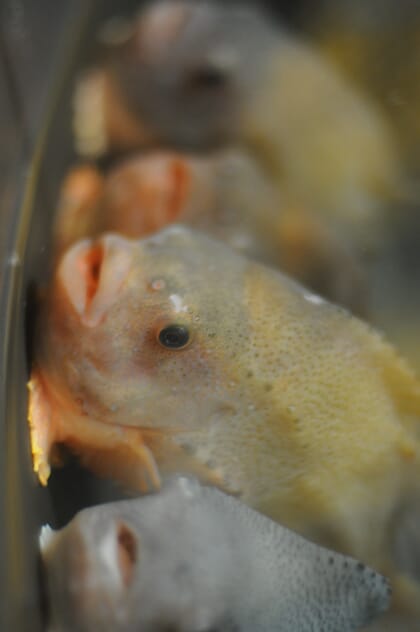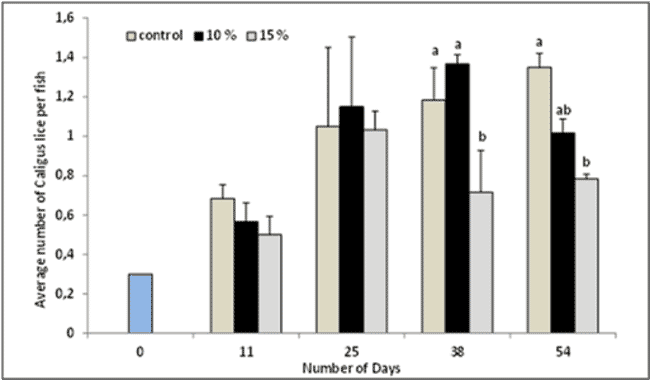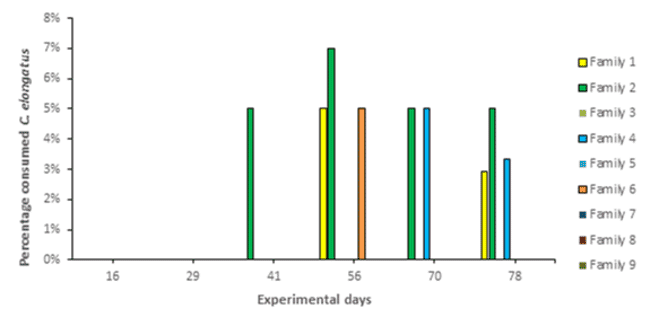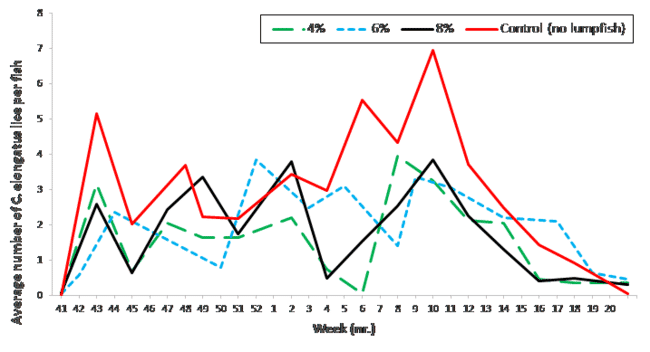
Background
Commonly referred to as sea lice, copepods from the Caligidae family drastically affect salmonid aquaculture worldwide, costing the Norwegian sector €400 million a year.
Two specific genera of the Caligidae family are responsible for the lion’s share of the economic losses caused by sea lice – namely Caligus and Lepeophtheirus. A key difference between the two genera is that Caligus members such as C. elongatus are generally much less host-specific, having been found in over 80 fish species, are better swimmers and mature stages are smaller than L. salmonis, which is essentially a salmonid ectoparasite.
Being less host-specific and better swimmers can explain the reported observations of rapid C. elongatus increase in specific periods of the year in northern Norway. Despite the occurrence of high infestation levels causing substantial losses by this species, there are no legal limits for the presence of this species on farmed fish.
Lumpfish are increasingly used as a biological control of sea lice. With documented data of the effectiveness of this species in grazing L. salmonis, lumpfish are a promising alternative to effectively counter sea lice infestations. They are very opportunistic and exploit multiple food sources when present, including mature sea lice from both species, though, no systematic knowledge has been gathered on their potential C. elongatus grazing activity.
This review summarises findings from trials as well as observations from where C. elongatus grazing has been documented, and provides recommendations for the use of lumpfish as a biological control of C. elongatus in Atlantic salmon aquaculture.
Reviewed studies
Study A
Lumpfish grazing efficacy on C. elongatus was assessed under two different stocking densities and a control group without lumpfish, on small-scale cages with Atlantic salmon. Stocking densities were 10 percent and 15 percent, and attached lice were counted every two weeks for 54 days. The stomach contents of the lumpfish were also investigated.
Findings: by the end of the study period, cages stocked with 15 percent lumpfish had an average of 0.78 C. elongatus per salmon, while those stocked at 10 percent and the control had 1.02 and 1.35 C. elongatus per salmon, respectively (figure 1).

Total average number of C. elongatus per fish recorded for each duplicate treatment. Values are presented as means ± S.D. Different letters indicate significant differences.
Study B
Two groups of lumpfish were given different dietary treatments during the tank-based period of the trial, and subsequently transferred to small-scale cages at sea to evaluate grazing efficacy on C. elongatus over 62 days. During the tank-based period, one group was given marine pelleted feed (control), and the other group received a mix composed of pelleted feed; live adult Artemia and frozen sea lice (LF group).
Findings The efficiency of C. elongatus grazing was nearly 40 percent higher in lumpfish LF groups, compared to control (figure 2). The results clearly suggest conditioning lumpfish with live feed and frozen sea lice prior to deployment at sea increases their ability to effectively graze on C. elongatus.

Total average number of C. elongatus per Atlantic salmon recorded for each duplicate treatment during each of the sampling dates of the sea pen study in Imsland et al. (2019).
Study C
The potential heritability of grazing preference traits was investigated in two separate studies, where 9 (C1) and 10 (C2) different lumpfish families were deployed at sea, in small-scale cages with Atlantic salmon. Grazing activity was assessed by lice-counting every two weeks and analysis of lumpfish stomach contents over a period of 78 and 73 days (C1 and C2, respectively).
Findings Results (figure 3) clearly indicate a parental effect on grazing behaviour, where specific lumpfish families were found to have higher predisposed preference for natural food sources, including C. elongatus. Both family trials showed variation in lice grazing between families. In particular, Study C2
revealed that the two families with the most pronounced C. elongatus
consumption shared the same father, despite having different mothers. This suggests that grazing preference might be influenced by passed paternal genetic information.

Mean percentage values C. elongatus found in nine lumpfish families assessed at each sampling date. Data refers to Study C1.
Study D
Grazing of C. elongatus was evaluated on lumpfish deployed in large-scale sea pens, in two different farms, Lerøy Aurora (Troms, Norway) and Nordlaks (Nordland, Norway). In both farms, lice counts were performed every second week, throughout a period of approximately 7 months.
The trial conducted at Lerøy Aurora evaluated different stocking densities, with lumpfish groups stocked at 4 percent; 6 percent and 8 percent and a control group without lumpfish, in duplicate sea pens. Observations from Nordlaks’ farm were collected during a seven-month period, from 12-large scale sea-pens with Atlantic salmon, where half were stocked with equal stocking densities of lumpfish.
Findings
Levels of salmon being infected with C. elongatus were considerably higher in sea cages without lumpfish. In particular, the overall sea lice infestation levels in Nordlaks’ sea cages without lumpfish resulted in a 600 g lower final slaughtering weight for the salmon.

C. elongatus occurrence per salmon (n=60) found in each sampling date, for each group stocked with different stocking densities of lumpfish (0 percent “control”; 4 percent; 6 percent and 8 percent), in large scale sea cages at Lerøy Aurora, northern Norway.
Study E
Observations were gathered from persons working in the salmon industry regarding lumpfish grazing activity on C. elongatus.
- A Faroese study on the stomach contents of 5,511 lumpfish showed that 13.5 percent of these contained sea lice, of which 80 percent contained C. elongatus. Consensus among Faroese salmon farmers was that lumpfish is effective means of C. elongatus control.
- C. elongatus infestation can reach high levels in Icelandic farming, and as such, are currently deemed more of an issue that L. salmonis. Large-scale trials in the Westfjords have shown evidence of lumpfish efficacy in the biological control of C. elongatus.
- Observations from Scotland show that lumpfish grazing efficacy can be difficult to accurately assess, as infestations can be seasonally influenced and, during summer, rapid re-infestation from wild fish species can occur.
Conclusions
The available studies and observations gathered in this mini review seem to suggest that lumpfish can indeed be effective as a control of this specific ectoparasite. Furthermore, evidence of paternal influence on the lumpfish’s preference for natural prey, shows the potential of breeding programmes to develop lumpfish lines that are inherently more effective at eating the lice. Additionally, their opportunistic feeding behaviour can allow for developing strategies in which potential grazing activity is enhanced, as documented in the live feeds study (Study B). Anecdotal evidence from salmon farmers also supports this conclusion.
Further information
The study was published under the title "Possible use of lumpfish to control Caligus elongatus infestation on Farmed Atlantic salmon:
a mini review, the Journal of Ocean University of China.
Financial support for this review was given by the Norwegian Seafood Research Fund (KEKS 901539).



